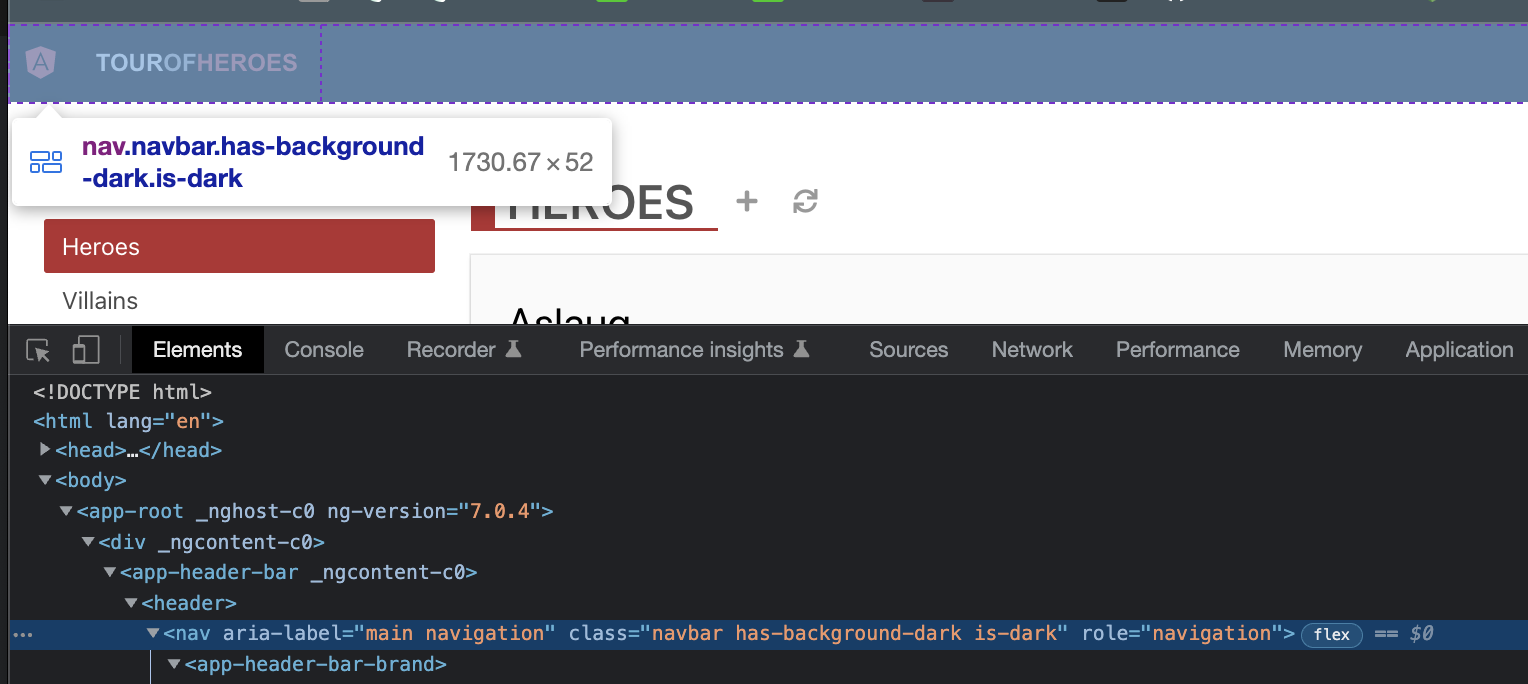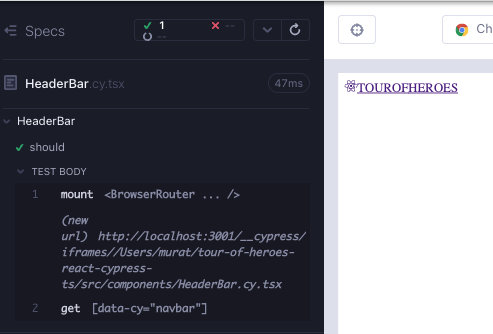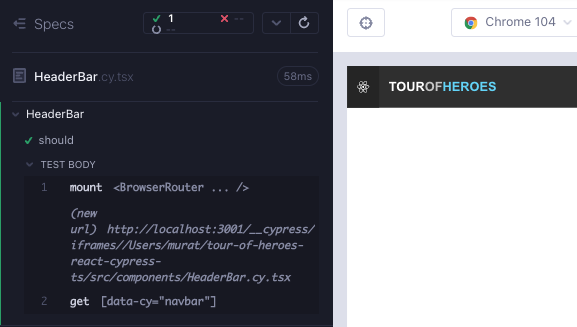In the Angular version of the app, there is a parent component above HeaderBarBrand. Let's create it too.
Create a branch feat/headerBar. Create 2 files under src/components/ folder; HeaderBar.cy.tsx, HeaderBar.tsx. As usual, start minimal with a component rendering; copy the below to the files and execute the test after opening the runner with yarn cy:open-ct.
// src/components/HeaderBar.cy.tsx
import HeaderBar from "./HeaderBar";
describe("HeaderBar", () => {
it("should", () => {
cy.mount(<HeaderBar />);
});
});// src/components/HeaderBar.tsx
export default function HeaderBar() {
return <div>hello</div>;
}In HeaderBar component, which is the child of HeaderBar, we added a top level data-cy selector with the value of header-bar-brand. Let's add a failing test to check the existence of the child component (Red 1).
// src/components/HeaderBar.cy.tsx
import HeaderBar from "./HeaderBar";
describe("HeaderBar", () => {
it("should", () => {
cy.mount(<HeaderBar />);
cy.getByCy("header-bar-brand");
});
});Insert the child component into the parent.
// src/components/HeaderBar.tsx
import HeaderBarBrand from "./HeaderBarBrand";
export default function HeaderBar() {
return (
<div>
<HeaderBarBrand />
</div>
);
}We get the same react-router related error that we got with the HeaderBarBrand component. If a child component is using react-router, when testing the parent component, we also have to wrap the parent in BrowserRouter (Green 1).
// src/components/HeaderBar.cy.tsx
import HeaderBar from "./HeaderBar";
import { BrowserRouter } from "react-router-dom";
import "../styles.scss";
describe("HeaderBar", () => {
it("should", () => {
cy.mount(
<BrowserRouter>
<HeaderBar />
</BrowserRouter>
);
cy.getByCy("header-bar-brand");
});
});The child component renders.
The specification shows that the child component is wrapped by a header and a nav There is also some css that gives it the dark theme. We can copy those off of the browser. We also add a data-cy selector to the top tag of the component.
// src/components/HeaderBar.tsx
import HeaderBarBrand from "./HeaderBarBrand";
export default function HeaderBar() {
return (
<header data-cy="header-bar">
<nav
className="navbar has-background-dark is-dark"
role="navigation"
aria-label="main navigation"
>
<HeaderBarBrand />
</nav>
</header>
);
}The component is looking great with CSS.
Realize that we did not necessarily go through a traditional RedGreenRefactor cycle; our Red in this case was the component not rendering in its final form and we kept improving that step by step.
What else can be tested at this point? We do not need to repeat the tests for the child component, because we covered all of it at the child. The only valuable additional check would be to check for an attribute of the nav tag. We can easily add that with Cypress testing library (Refactor 1).
// src/components/HeaderBar.cy.tsx
import HeaderBar from "./HeaderBar";
import { BrowserRouter } from "react-router-dom";
import "../styles.scss";
describe("HeaderBar", () => {
it("should", () => {
cy.mount(
<BrowserRouter>
<HeaderBar />
</BrowserRouter>
);
cy.getByCy("header-bar-brand");
cy.findByRole("navigation");
});
});// src/components/HeaderBar.test.tsx
import HeaderBar from "./HeaderBar";
import { render, screen } from "@testing-library/react";
import { BrowserRouter } from "react-router-dom";
import "@testing-library/jest-dom";
describe("HeaderBar", () => {
it("should render error", async () => {
render(
<BrowserRouter>
<HeaderBar />
</BrowserRouter>
);
expect(await screen.findByTestId("header-bar-brand")).toBeVisible();
});
});The main takeaway in this section is the parent-child relationship between the components, and a demo of how top level data-cy selectors make child components easier to reference in higher level tests.
If a child component is using react-router, when testing the parent component we also have to wrap the parent in BrowserRouter.
In a parent component, we do not need to repeat the tests for the child component, because we covered all of it at the child. The same thought process applies to higher level tests with e2e.
When designing the component, we do not necessarily have to go through a traditional RedGreenRefactor cycle. When our test tool is also the design tool, our RGR can as well be incremental visual enhancements to the component whilst adding classes and css.


